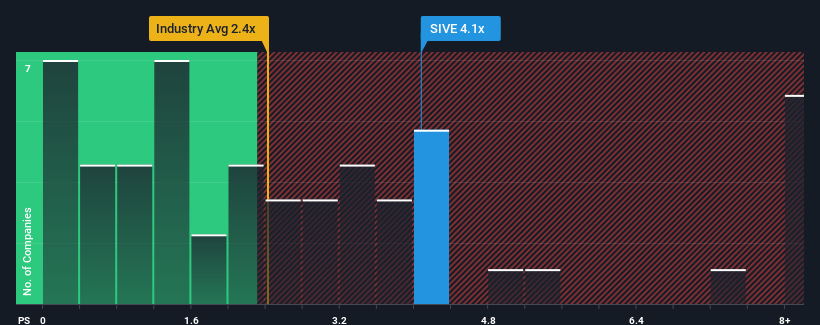- Sweden
- /
- Semiconductors
- /
- OM:SIVE
Investors Give Sivers Semiconductors AB (publ) (STO:SIVE) Shares A 26% Hiding

Sivers Semiconductors AB (publ) (STO:SIVE) shares have retraced a considerable 26% in the last month, reversing a fair amount of their solid recent performance. Instead of being rewarded, shareholders who have already held through the last twelve months are now sitting on a 32% share price drop.
Although its price has dipped substantially, you could still be forgiven for feeling indifferent about Sivers Semiconductors' P/S ratio of 4.1x, since the median price-to-sales (or "P/S") ratio for the Semiconductor industry in Sweden is also close to 3.6x. While this might not raise any eyebrows, if the P/S ratio is not justified investors could be missing out on a potential opportunity or ignoring looming disappointment.
View our latest analysis for Sivers Semiconductors

How Sivers Semiconductors Has Been Performing
Recent revenue growth for Sivers Semiconductors has been in line with the industry. Perhaps the market is expecting future revenue performance to show no drastic signs of changing, justifying the P/S being at current levels. Those who are bullish on Sivers Semiconductors will be hoping that revenue performance can pick up, so that they can pick up the stock at a slightly lower valuation.
If you'd like to see what analysts are forecasting going forward, you should check out our free report on Sivers Semiconductors.Do Revenue Forecasts Match The P/S Ratio?
There's an inherent assumption that a company should be matching the industry for P/S ratios like Sivers Semiconductors' to be considered reasonable.
If we review the last year of revenue growth, the company posted a terrific increase of 25%. Pleasingly, revenue has also lifted 102% in aggregate from three years ago, thanks to the last 12 months of growth. So we can start by confirming that the company has done a great job of growing revenue over that time.
Turning to the outlook, the next three years should generate growth of 49% each year as estimated by the only analyst watching the company. Meanwhile, the rest of the industry is forecast to only expand by 15% each year, which is noticeably less attractive.
With this in consideration, we find it intriguing that Sivers Semiconductors' P/S is closely matching its industry peers. Apparently some shareholders are skeptical of the forecasts and have been accepting lower selling prices.
What Does Sivers Semiconductors' P/S Mean For Investors?
Sivers Semiconductors' plummeting stock price has brought its P/S back to a similar region as the rest of the industry. While the price-to-sales ratio shouldn't be the defining factor in whether you buy a stock or not, it's quite a capable barometer of revenue expectations.
We've established that Sivers Semiconductors currently trades on a lower than expected P/S since its forecasted revenue growth is higher than the wider industry. There could be some risks that the market is pricing in, which is preventing the P/S ratio from matching the positive outlook. At least the risk of a price drop looks to be subdued, but investors seem to think future revenue could see some volatility.
Before you settle on your opinion, we've discovered 3 warning signs for Sivers Semiconductors that you should be aware of.
If these risks are making you reconsider your opinion on Sivers Semiconductors, explore our interactive list of high quality stocks to get an idea of what else is out there.
If you're looking to trade Sivers Semiconductors, open an account with the lowest-cost platform trusted by professionals, Interactive Brokers.
With clients in over 200 countries and territories, and access to 160 markets, IBKR lets you trade stocks, options, futures, forex, bonds and funds from a single integrated account.
Enjoy no hidden fees, no account minimums, and FX conversion rates as low as 0.03%, far better than what most brokers offer.
Sponsored ContentNew: Manage All Your Stock Portfolios in One Place
We've created the ultimate portfolio companion for stock investors, and it's free.
• Connect an unlimited number of Portfolios and see your total in one currency
• Be alerted to new Warning Signs or Risks via email or mobile
• Track the Fair Value of your stocks
Have feedback on this article? Concerned about the content? Get in touch with us directly. Alternatively, email editorial-team (at) simplywallst.com.
This article by Simply Wall St is general in nature. We provide commentary based on historical data and analyst forecasts only using an unbiased methodology and our articles are not intended to be financial advice. It does not constitute a recommendation to buy or sell any stock, and does not take account of your objectives, or your financial situation. We aim to bring you long-term focused analysis driven by fundamental data. Note that our analysis may not factor in the latest price-sensitive company announcements or qualitative material. Simply Wall St has no position in any stocks mentioned.
About OM:SIVE
Sivers Semiconductors
Through its subsidiaries, develops, manufactures, and sells chips, components, modules, and subsystems in North America, Europe, and Asia.
Adequate balance sheet low.
Market Insights
Community Narratives



